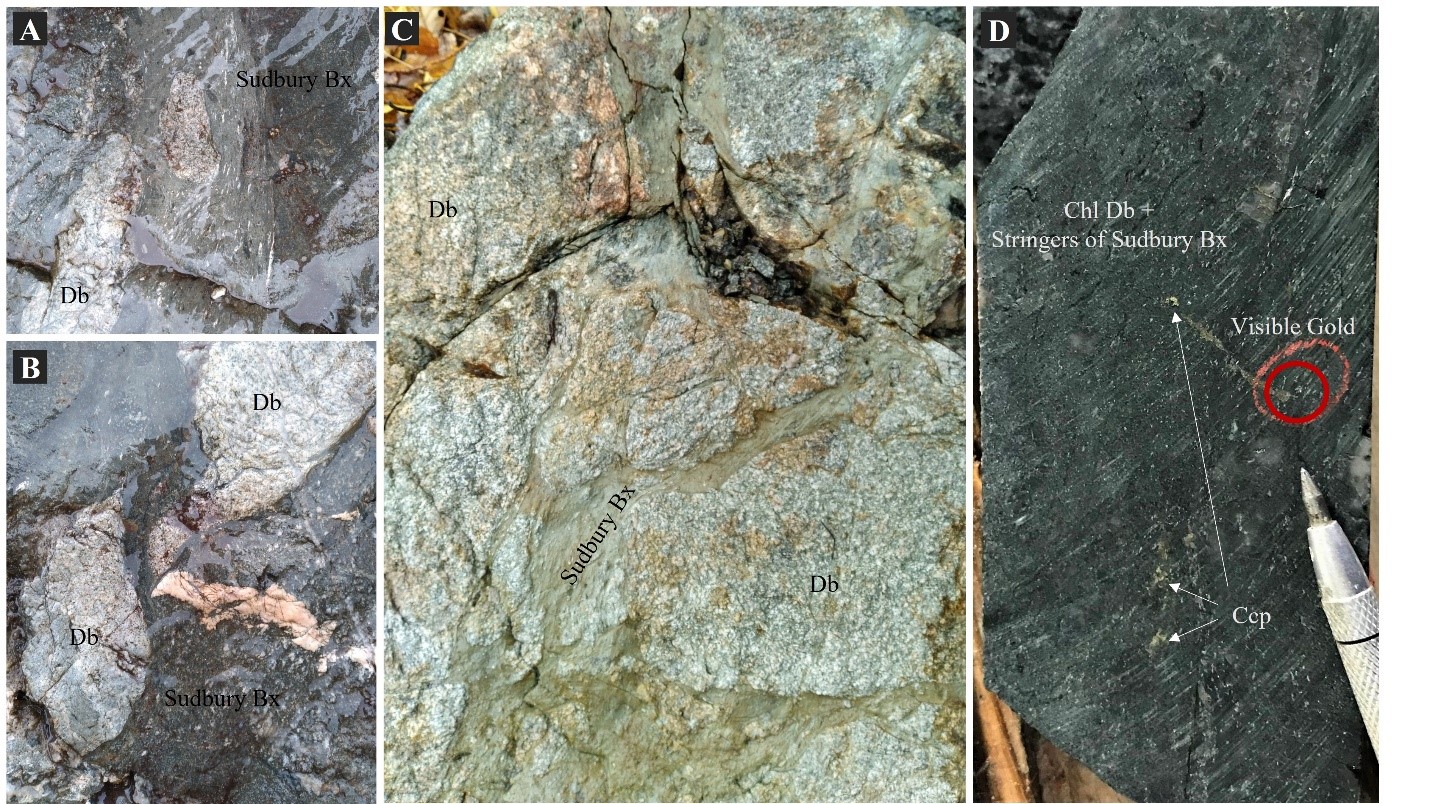Glade
Highlights
- Shallowly defined gold mineralization demonstrated in drilling and channel samples over approximately 300 m strike length that remains fully open in all direction with potential for very high-grade mineralization.
- 5.17 g/t Au over 22.67 m, including 113.00 g/t Au over 0.96 m in AG-21-097
- 0.82 g/t Au over 40.5 m, including 7.76 g/t Au over 2.9 m in AG-22-103
- 0.72 g/t Au over 37.45 m, including 16.0 g/t Au over 1.0 m in AG-22-105
- 7.19 g/t Au over 4.0 m, including 12.40 g/t Au over 1.0 m in channel sample from AGT-21-002
- Strike length of entire Glade mineralization trend proposed up to 1.7 km by ALS GoldSpot’s artificial intelligence generated targeting in May 2022.
- Located ~1 km south of the Scadding mine
- Evidence from drilling and surface exploration indicates that Glade is part of the same/extended MIAC mineral system which formed the very high grade gold mineralization at the Scadding mine
- New PGE mineralization potential in Nipissing diabase from 2022 drilling
- 0.16 g/t Pd with anomalous Cu and Ni over 4.00 m in AG-22-103
Summary
In the Glade Area, Ontario Geological Survey maps and historical exploration identified a broad zone of disruption, alteration, deformation, and mineralization that extends over a strike length of approximately 300 m, with high-grade gold in quartz veins historically reported.
Work in the Glade area has primarily focussed on the Glade West (AGT-21-005/006) and Glade East showings (AGT-21-002) identified in the 1930’s and 1940’s, approximately 260 m apart. The showings were prospected by Macdonald Mines in 2019 where grab samples from Glade west returned up to 18.53 g/t Au and channel samples from Glade East in 2021 returned 7.19 g/t Au over 4.0m, including 12.40 g/t Au over 1.0m. IP surveys were completed over the Glade area in 2020 in order to assist with drill targeting.
Drilling under Glade West revealed a large alteration and mineralized system where shear-hosted quartz veins are surrounded by networks of gold mineralized, multi directional and variable spaced quartz tension veins concentrated in the Nipissing intrusion. New observations from 2022 drilling also identified the potential for the Nipissing diabase at Glade to host PGE mineralization, with 0.16 g/t Pd and anomalous Cu and Ni over 4.0 m in hole AG-22-103.

Visible Gold was observed in quartz veins in 5 out of the 6 drillholes completed by the MacDonald Mines at Glade to date. In certain quartz veins, visible gold is associated with iron-rich chlorite alteration emplaced and crosscutting the quartz veins. This association between gold and iron-rich chlorite is similar to the association between iron-chlorite and gold at the Scadding Deposit. At Scadding, gold mineralization is primarily associated with the chlorite to chlorite-quartz to quartz-chlorite mineral facies, with the transition between these facies demonstrated very clearly at the Villeneuve trench near the East-West zone. Contrastingly at Glade, gold mineralization is primarily associated with the quartz to quartz-chlorite mineral facies, with the first evidence of gold with primarily chlorite observed in 2022 drilling in AG-22-103; the figure below demonstrates gold mineralization at Glade, with the quartz rich facies on the lefthand side and the chlorite rich facies at depth on the right hand side. The relationship between the mineralization observed at Glade and the Scadding Deposit, just 1 km north, potentially represents a considerable extension to that MIAC mineralized system.

In the summer of 2022, the high priority target proposed by ALS GoldSpot Discoveries southeast of the main Glade target was prospected. Gold mineralization was identified within the same quartz-carbonate veining in sheared Nipissing diabase, with up to 2.36 g/t Au measured in muck sample beside historic blast pit. This further supports the extension of Glade mineralization proposed by ALS GoldSpot over a strike length of 1.7 km, proven in drilling and channel samples thus far over approximately 300 m.
Sudbury breccias have been observed at surface at Glade and in drill core from Scadding mine and Glade. In the Glade area at surface, Sudbury breccias occur as networks of centimeter- to meter-wide corridors of brecciation formed in Nipissing intrusions that become preferentially re-activated as shears zones. The matrix of the Sudbury breccias is very fine grained, with rounded clasts of the host rock units and flow-like foliation, which is characteristic of Sudbury breccias as they formed during intense cataclasis and friction melting of the host rocks. In drilling and at surface, the deformed corridors of Sudbury breccias are zones of preferential alteration, veining and mineralization. The breccias are variably albitized, and then overprinted by gold-mineralized chlorite replacement, or cut by quartz and quartz-chlorite veins in the apical parts of the systems. These Sudbury breccias are a primary control on deformation and fluid-infiltration in the Nipissing intrusions away from the Nipissing-Espanola contact.

